Bees have been in the media spotlight recently due to their declining populations and the huge implication that their dwindling numbers are having on food production. Due to this, reports have claimed that beehives are now disappearing at an alarmingly rapid rate, which is largely due to pesticides and mites, as well as climate change.
As people are recognizing the seriousness of the issue, many are trying their best to help by keeping their own beehives, which is a surprisingly simple, but very effective, task to carry out.
Not only will it help declining bee populations, but it will also mean that you can produce your own organic honey for your personal consumption.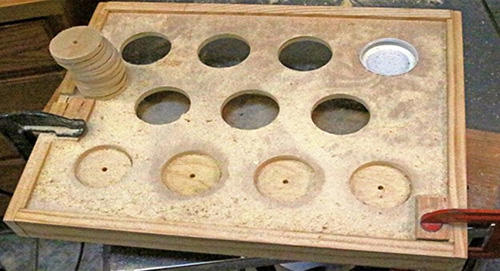 All that you will need is a pre-made bottom beehive kit, plywood, and some jars for the main beehive, along with:
All that you will need is a pre-made bottom beehive kit, plywood, and some jars for the main beehive, along with:
- one piece of 2″ x 12″ x 6′ wood (cut two pieces to 22″ each for the sides);
- one piece of 2″ x 12″ x 6′ wood (cut two pieces to 18″ each for the front and back);
- one piece of 1″ x 1″ x 6′ wood (cut two pieces to 22″ each for the top frame’s left and right sides);
- one piece of 1″ x 1″ x 6′ wood (cut two pieces to 18″ each for the top frame’s front and back sides);
- one piece of thick plywood cut to 16″ x 20″; 12 big mouth quart-sized jars for the honeycomb; one box of 1″ wood screws;
- one can of any dark wood stain; and, of course, your bees.
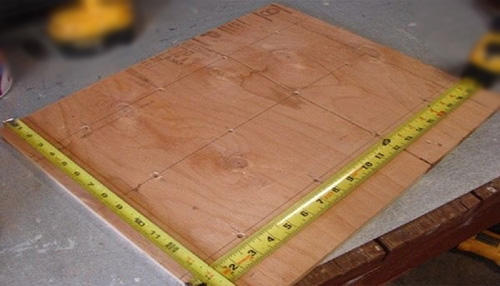
The plywood will act as a frame for the beehive kit and therefore can be stained however you choose. 12 holes should then be drilled into the 16″ x 20″ piece of plywood which should be big enough to screw the mason jars into.
Related: How to Start a Beehive
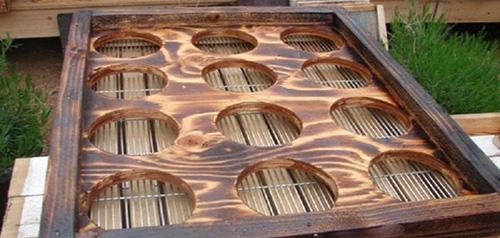 Following this, the top frame can be made by screwing together the four pieces of 18″ and 22″ plywood, which can also be stained any colour.
Following this, the top frame can be made by screwing together the four pieces of 18″ and 22″ plywood, which can also be stained any colour.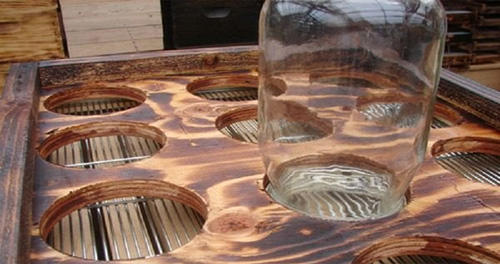 Following this, sanitize each of the 12 mason jars before twisting them upside-down into the holes, before adding washers or shims inside the jars to support the weight of the honey that will be there later.
Following this, sanitize each of the 12 mason jars before twisting them upside-down into the holes, before adding washers or shims inside the jars to support the weight of the honey that will be there later.
After the lids of the jars have been screwed on, they should fit perfectly into the drilled holes with less than a 1/16″ gap between the jar and the beehive hole.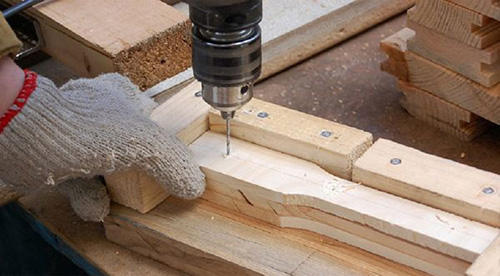 After placing starter strips or empty combs inside the jars, you can now add your bees. They will immediately become attracted to the comb, and start their work making the honey.
After placing starter strips or empty combs inside the jars, you can now add your bees. They will immediately become attracted to the comb, and start their work making the honey.
Once the jars are filled, remove them and leave them out overnight, so that the bees will return to the hive. Fill the remaining space from the jars with honey.
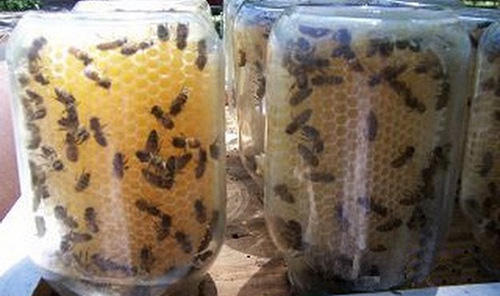 You will notice that the jars will heat up quickly when the lids are on, due to there being no ventilation. Therefore, they need to be kept in the shade.
You will notice that the jars will heat up quickly when the lids are on, due to there being no ventilation. Therefore, they need to be kept in the shade.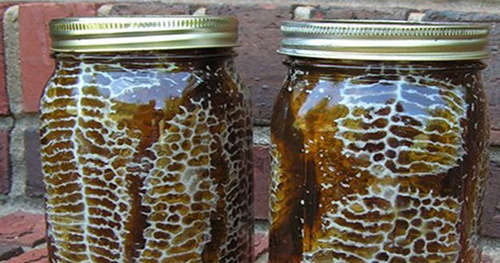 Once you have the basic supplies, the rest should come easily, providing you with a constant supply of delicious honey, whilst ultimately saving a rapidly declining population.
Once you have the basic supplies, the rest should come easily, providing you with a constant supply of delicious honey, whilst ultimately saving a rapidly declining population.
Editor’s note: This article was gladly contributed by Jess Murray and first appeared on Truth Theory.
Jess Murray is a wildlife conservationist and writer who has spent a lot of time working and studying in South Africa. She is now striving to spread awareness about global conservation issues and the truth behind faux conservation facilities throughout the world.
You may also like:
 How to Adjust the pH in Soil and Water for Abundant Harvests
How to Adjust the pH in Soil and Water for Abundant Harvests
The Only 10 Plants You Need In Your Medicine Cabinet (Video)
12 Woodworking Projects for Preppers and Homesteaders

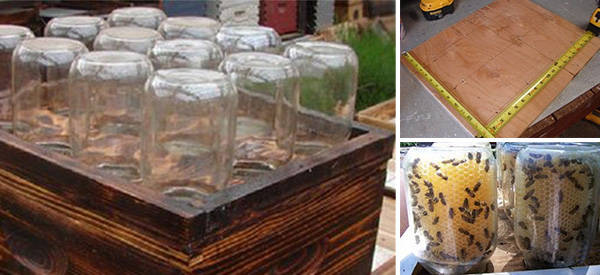




















won’t they suffocate?
I missed something apparently. How do you separate the bees from the honey?
From what i read you will replace the lif on the hive that you have placed in the shade. The bees come up in to the jars and build the honey cones from the top down. When the jar is full of honey cone you replace it with a new jar. Seems to me would be a very messy job geting the honey and honey cone out of the jar. You would have to use a heated spoon or something like it to dig it out.
There were so many questions of a similar nature that I couldn’t decide which of them was the best to reply to. I settled on the first one.
The board with the jars will sit on the top of an existing bee hive. It replaces the standard lid of the hive. The bees are naturally inclined to fill any empty space with comb and honey and so they will build comb in the empty jars just as they would one of the frames in a hive. Since they jars are open to the sunlight (unlike the normal hive which is completely enclosed) it will naturally get hotter just like a car sitting in the sun. That’s why you keep it in the shade. As far as getting the honey out, many people enjoy eating the wax comb along with the honey. If you aren’t one of those people simply place the jar in a pan of water and heat the water until the wax is all melted. As it cools the wax will settle at the top of the jar which you can then remove and throw away or wash and use for candle making or other crafts that require wax (lip balm etc.)
Beeswax melts at about 147 degrees Fahrenheit. Honey can be heated to that temperature as well, but I think you’ll be disappointed with it. Just eat it as comb honey. Comb honey is absolutely divine on toast.
Note the use of a queen excluder (not mentioned) to keep the queen and brood out of the jars. The bees could be removed from the jars by placing the jars in a dark room with a window at one end.
I’ve never tried this, but I am guessing it would work. It would be a unique way to market your honey if you don’t own an extractor. You also wouldn’t have a lot of money tied up in supers.
Except for text in brackets, I quote from the article; “Once the jars are filled, remove them” [from the hive] “and leave them out” [next to the hive entrance] “overnight, so that the bees will return to the hive.”
Miz Kitty: You leave the jars out overnight, uncapped. Bees will return to the hive. niio
An answer by the author would be nice, I was wondering the same thing.
The author is not a beekeeper. Please find a real keeper to mentor you.
I agree. This whole article doesn’t make any sense. It is unclear of what you are building and how the process continues to work. How can the bees replenish if you keep them closed up in a jar?
The bees will return to the base hive in the evening. After they finish building the wax out in the shape of the comb, and fill it with honey, and have gone back down into the hive for the night, you can remove the jars, pour more honey in around the filled sections, seal them and either store to use or sell them. I think this sounds like a great idea. I had a hive for over 10 years and missed using a lot of honey because I did not have an extractor. Smart idea.
That was my first question, too.
That’s what I was wondering…. when do you release the bees?
And freeze in the winter
“All you need is a pre-made bottom beehive kit…”
This is just plans for the TOP of a beehive kit that will facilitate the honey harvest. I don’t have any idea if it will work well.
FYI
this is 100% crap.
This looks like it’d be ok in Hawaii, where doesn’t get too hot or too cold.
Hello – I have the same questions as Calway. Do the bees stay inside the jar and die or is there a certain time they should be released?
Not sure about this. Wouldn’t the bees starve over winter if you took all their honey? Maybe you leave some?
Hi, you only do this in the summer, Go to youtube and watch mason jar harvest,
I’m a backyard beekeeper. I wouldn’t do this until you have a full hive first. I only pull 25% of the hive honey for people, and another 25% for my honeybank to feed the bees in February, and leave the rest in the hive. I extract the honey by scratching the honey cells with a fork on one side of the frame and drain over a clean cookie sheet, then do the flip side. The bees will clean up the residue if you let them. Bees will also build comb in any shape you give them a frame for. Bees go back to their hive at sunset.
Except for text in brackets, I quote from the article; “Once the jars are filled, remove them” [from the hive] “and leave them out” [next to the hive entrance] “overnight, so that the bees will return to the hive.”
I think it means the bees go down in to the actual hive below the jars at night. That’s why at night is when you can remove the jars and replace them with empty ones.
Please explain how you harvest the honey. Aren’t you killing the bees?
That’s what I was wondering…. when do you release the bees?
Not sure about this. Wouldn’t the bees starve over winter if you took all their honey? Maybe you leave some?
It would seem that clear jars will get hot when sun beats down on them. Shouldn’t they be kept under some sort of shade?
Bee populations are on the rise. Bees were originally brought here from Europe. They would only reproduce once a year. Now that African bees were introduced, which reproduce 7-8 time a year, they are cross breeding, the population is increasing dramatically. This is from a bee keeper in Southern California and says the story of decreasing population is a climate change hoax.
The only bees counted for the “statistics ” are commercial beekeepers. Find the original article and it tells you what hives are being counted.
I am a small hobby beekeeper in Arkansas, no it is not a climate change hoax. This is a serious problem, google it and read about the problems large mobile beekeepers who pollinate commercial crop are having. Or go to a local meeting of beekeepers and ask around. Don’t listen to this yahoo who heard something from someone somewhere far away, ask beekeepers who are your neighbors.
Listening to Google is a problem. Don’t believe what they say. Run by a bunch of liberals.
Interesting article. Would love to read comments from other bee keepers
I am interested in this but there are too many details left out for this article to be helpful for a beginner. What happens to the bee during the winter?
The bee population of a hive dies back (naturally) during the winter and the bees live off of the honey and pollen they have stored. Some trees (like the Oak) and flowers bloom early and the bees collect in cool weather. They stay in the hive when it rains.
You leave enough honey in the main hive for them to reproduce and live off of during the winter or supplement with sugar syrup. The layer of the hive with the jars is above the main box(super). For winters in Idaho you don’t harvest all the honey, just the excess. The brood is largely raised in the bottom one or two deep supers and the shallow supers are added onto that. That’s where the harvested honey comes from. The top supers are where the jars would be. When you take a jar of honey and comb, add an empty jar and leave the taken out jar(the full one) near the hive long enough that the bees return to the main hive for the night. Do some reading and study up a bit before taking a project like this on. Otherwise this seems like a good idea for a hobby beekeeper. Good Luck!
this is a great idiea i have got to make and do this this is a wounderful insite as to make it easier for bees to help fill the jars great idiea
This is a grossly incomplete article. Just from the questions I have, it could put this article at about 30% complete. Many details have been left out as to the set up and operation of this unit. The author needs to rethink this article and put themselves in the place of a complete beginner who doesn’t know anything about bees, honey or how they make honey. How do bee hives work? How do you attract or acquire the bees? How do bees enter this contraption?
where do you get a pre-made beehive kit and the combs? The list goes on and on!
You are asking the right questions. Now just go to YouTube and ask again.the best video I have seen was made by the BBC called Hive Alive. Just to get you started.
Bomgaars sells the kits, and you can find them on Amazon.
I am thinkin’ ……. PROBABLY NOT an article for a beginner, HOWEVER, …. IF this works it really shows how versitile bees can be and also provide some ideas on variations of a bee hive ……. I think I would use clear plex on SOME sections to provide the bees a “tropical area” and another more shaded and then an area that is dark ……. Being inside a jar, closed, REALLY does NOT seem very attractive if I were a bee………jus’ sayin’
I agree that this is a terribly written article that leaves out quite a lot of important information and the pictures included by the author don’t illustrate enough to fill in the gaps. The author seems to have assumed the readers already have basic knowledge of beekeeping.
It is also apparent that most of the comments are from individuals who have never had any experience with honeybees and beehives. To answer most of the commentors’ questions, the honeybees are not held inside the jars. The necks of all the jars are open, allowing the bees to freely enter and exit the jar to gather pollen and do their work of making honey in the wax honey combs that have been placed inside the jars. The bees won’t suffocate inside the jars.
If you don’t put this DIY beehive in the shade, as the author recommends, the heat generated by the sun’s rays will melt the wax combs. With no honey combs, the bees will all swarm and simply fly away to seek a new home.
Regarding the questions concerning the bees freezing in winter temperatures, think for a moment. If that was an issue, there would be no honeybees in cold climate areas after just one winter. But we know, that is not the case because there are honeybees that start showing up each spring, buzzing busily around blooming flowers, plants and shrubs. A honeybee has the ability to slow their body’s metabolism, going into a “semi-hibernation” mode when the ambient temperature drops. To stay warm, all of the honeybees bunch together tightly, sharing their bodies’ warmth. They also “shiver” their wings to generate additional body heat (the same we humans do when we shiver) and help distribute that warmth throughout the huddled mass of honeybees. That is what lets them survive cold winter temperatures and be ready to start working again the following spring.
Once the honeybees have filled the cells of the wax combs with honey, the beekeeper uses a beehive smoker to gently fill the beehive base and jars with smoke, which makes the honeybees very docile and sleepy, but does not harm or kill them. When there is no more activity from the honeybees in the beehive, the beekeeper would “unscrew” each jar with the filled honey comb inside, remove it from the beehive, and screw on a sanitized jar lid. When a glass jar with a filled honey comb is removed, a new, sanitized glass jar with a new, empty wax comb would be “screwed” back into the empty hole, and the process would begin once more. It is important to work quickly when removing the honey-filled jars and replacing them with new empty comb-filled jars because the smoke only relaxes the honeybees and makes them docile. If a beekeeper takes too long in removing the honey, the honeybees will wake up and will no longer be docile. They will begin to attack this “invader” of their home and honey combs! Proper protective beekeeping gear and clothing, including a beehive smoker, a wide-brimmed hat, with small-opening netting that covers the head, neck, upper back and upper chest, flexible leather gauntlet gloves that cover half-way to two-thirds up your forearms that are held snugly to your forearms with one or two pairs of heavy-duty rubber bands, and a long-sleeved, heavy denim or thick flannel shirt and heavy denim jeans or coveralls with another one or two pairs of heavy-duty rubber bands to hold your pant legs firmly to your legs just above your work (or rain) boots. You could also wear a disposable heavy-duty paper hazmat suit over your regular clothing, making sure there are no openings at your collar, wrists or ankles where one (or more) honeybees could get inside your protective clothing.
If you are actually interested in beekeeping and collecting the bees’ honeycombs to provide a supply of honey for yourself and your family, I would highly recommend reading the numerous articles and watching the videos available on the internet.
And after you get the hive built where do you obtain bees and how many will this colony support?
That’s part of the problem with these one or two page articles. They are too short to be adequately developed by the author. Sometimes you need more than one paragraph to describe how to do brain surgery.
LCC, I believe you can order a queen bee with a few workers off of the internet.
I think they are somewhat in a “frozen state” (not sure) and you introduce them to the hive.
Of course it would be my luck they would all wake up and fly away.
I am a bee keeper. I learned everything from a few books and days dedicated to YouTube videos. The Fat Bee Man has the best videos and he has a bee “teaching yard”. Only attempt to keep bees after you feel confident in how to take care of them. They are not dogs or cats, and are a BIG responsibly. You are dealing with living things and they require knowledge and COMMON SENSE. You can buy “package bees”. Bees NEVER “go to sleep” just because you smoke them. Bees NEVER hibernate. They get cold and go into “torpor”. Look it up. They freak out when you smoke them, and bee keepers use that to their advantage. The bees think the hive is on fire and ” fill up ” on honey, that just makes them a little slower and a little more docile. The jar thing described here is ONLY AN ADD ON TO AN EXISTING HIVE. And should be in an empty hive body, in the dark, with the top back on the hive. Like a Langstroth, a typical bee hive.
If you haven’t watched about 100 bee videos by a real keeper, I’M BEGGING YOU, PLEASE DON’T JUST GO ORDERING BEES. A responsible keeper is also responsible for all the future bees in about a 5 mile radius of the hive. Once you understand why you are responsible for future bees around your hives, then that might be a good time to become a keeper, if I don’t tell you first. Find a local club and go work with one of them first, see if you even want to.
P.s. you are responsible because you can’t always stop a swarm from your hives if you have more than one, and bees also need new genetics just like any ” animal husbandry “, they will breed with what is around. Do you know the genetics of all the bees in your neighborhood? You can’t know that! But you can help the wild hives get better if you bring in great qualities.
Went to the original article, the author gets called out on comments there also. Looks like this needs to be modified to actually work.
I’ve been raising bees since about 1965, and I have the beekeeping merit badge. This is a fun thing to do if you have the time for it and makes a good gift. Preppers would probably be better advised to lake classes and see just how rewarding keeping bees really is. It’s not for everyone but the bees really need a break. I hope this post at least gets a couple of you to give it a try!
as an avide bee keeper i seen right to the point of how all that works any one who has raised bees and have hives knows what to do and can see the concept without a lot of thought dont try and take something that is self explanatory and try to turn it into a mountain it doesnt take a real genouis to see how to do this and as far as finding bees there are millions of places to gget and buy starter hives and bees
Your comments are as poorly written as the article.
Headhunter is right. Don’t expect this article to teach you all about bees! It is just to get you interested in learning more IF YOU WANT TO LEARN MORE. Like everything in life, take it as a reason to dive deeper into a subject. No one is going to tell you EXACTLY HOW TO DO IT. You have the Internet look it up people. Learn to dig deep into something on your own. I know that people are on this site not just wanting everyone else to do it for you. I have faith in all of you to learn more. Go find the answers and ask more questions! And find the answers to those too! Never stop asking. But you won’t find all the answers here, to any of these articles. They are just the diving board, now jump.
thank you violet for your helping to makem understand
I guess most folks missed “All that you will need is a pre-made bottom beehive kit” in the article. All this contraption would do is replace a 10 frame super in a standard Langstroth hive, commonly called a Lang. If you don’t know what a super is, you probably won’t ever raise bees.
There appears to be a wire rack involved that is not on the parts list. Capping the jars with bees inside sounds cruel but that seems to be the instruction. How to extract the honey would be good to know as would the proper use of shims or washers. Lastly, does the author really mean screwing the jars into the wooden holes or inserting the jars into the wooden holes?
the wire rack you refer to is call a queen xcluder it stops the queen bee from getting to the comb and laying eggs to make more bees you have to use it to stop the queen from destroying the honey you eat for human consumption
and noone is capping the bees in the jar they are showing the bees as to how they make the honey and comb an when the bees finish makeing it they move out of the way so the bees dont get caped in the jar lmao
Except for text in brackets, I quote from the article; “Once the jars are filled, remove them” [from the hive] “and leave them out” [next to the hive entrance] “overnight, so that the bees will return to the hive.”
As one reader posted, this instruction was more for folks who are already experienced in beekeeping and not for tyros like me who doesn’t know a honey bee from a carpenter bee. I can tell the difference between a bumble bee and a honey bee, however, so that gives me one leg up from those who don’t know the difference.
For those of us who have not yet enrolled in Beekeeping 101, perhaps that would be a good place to start with an article about beekeeping basics.
I can see from the comments by experienced beekeepers this is a fairly straight-forward process if you are already keeping bees.
I can also see from the comments that a lot of us are at the stage, “Duh, what?”
You are right, left Coast chuck. But look at this website as a starting point and then if you like any idea, go and learn more, lots more. People expect too much from one article. If anyone thinks one article can teach all you need to do anything reasonably well, I’m sorry to be the bearer or bad news but … um, no.
How do you remove the bees from the jars?
how can I print the video without all the comments
To follow up on my comment above, Claude, how about an article along the lines of Beekeeping 101 for folks who are interested and would like to start but, perhaps, don’t know what questions to ask on line to get accurate, succinct information. Maybe I just don’t know how to appropriately search the web, but about 50 percent of the time I either get a highly technical article that is way above my level or I can’t find anything that remotely resembles what I am searching for. The other 50% of the time I get at least some helpful info.
That’s why many times the articles on this site prove to helpful, not only do they present the information concisely in a form that can be understood, but the comments from hands-on users that follow along with the article are equal as helpful as the main article itself. And sometimes more helpful than the original article, but at least the article stirred the follow-along discussion.
Beekeeping is very localized…more so than gardening. Find a mentor. Look for a beekeeping club or community education program in your area, Does your county fair or state fair have a beekeeping exhibit where you can find names? Are there natural food or health food stores that sell local honey where you can pull a name off of a label? Do you have land that would be attractive to a local beekeeper where he/she could set out hives and you could collect the traditional pound per hive rent?
YouTube, search ” the fat bee man”
Hi, We are going to try this, it looks very neat. I have read so of the comments, People, only do this in the spring and summer. Not the winter.
The bees are disappearing because of companies like Monsanto who peddle GMOs.
Please republish this. If you have more, like barrel hives and so on… niio